| 1 | Amazon tree boa |

Maximum length: 188cm.
If there are genes specifically responsible for snake aggression, then the Amazon tree boa probably has 90% of them. This is a common south American species, with an IUCN conservation tag of “least concern”. They rest on branches, but spend more time on the ground than the lazy emerald tree boa. It belongs to the Corallus family, distantly related to the simple Boa family of boa constrictors.
The Amazon tree boa has long had a fearsome reputation among reptile keepers. They’ll bite for no reason whatsoever, at the slightest imagined provocation. Amazon tree boas will attack if you pick them up, give them food, or even open their cage. This species is so aggressive that changing the water bowl becomes a stealth mission worthy of MI6. The Amazon tree boa has long curved teeth designed for chewing through bird feathers, and if enraged, they’ll use these to place an agonisingly deep bite wound in your arm.
People disagree on whether this snake can be tamed. Some day it can be done with great effort, while other’s say it’s impossible. The only saving grace for a keeper is their diet. This snake is extremely non-fussy, and eats almost anything in nature. At 1.5-1.8 metres, they’re too short to constrict their owners, but their fangs are a force to be reckoned with.
| 2 | Caspian whipsnake |
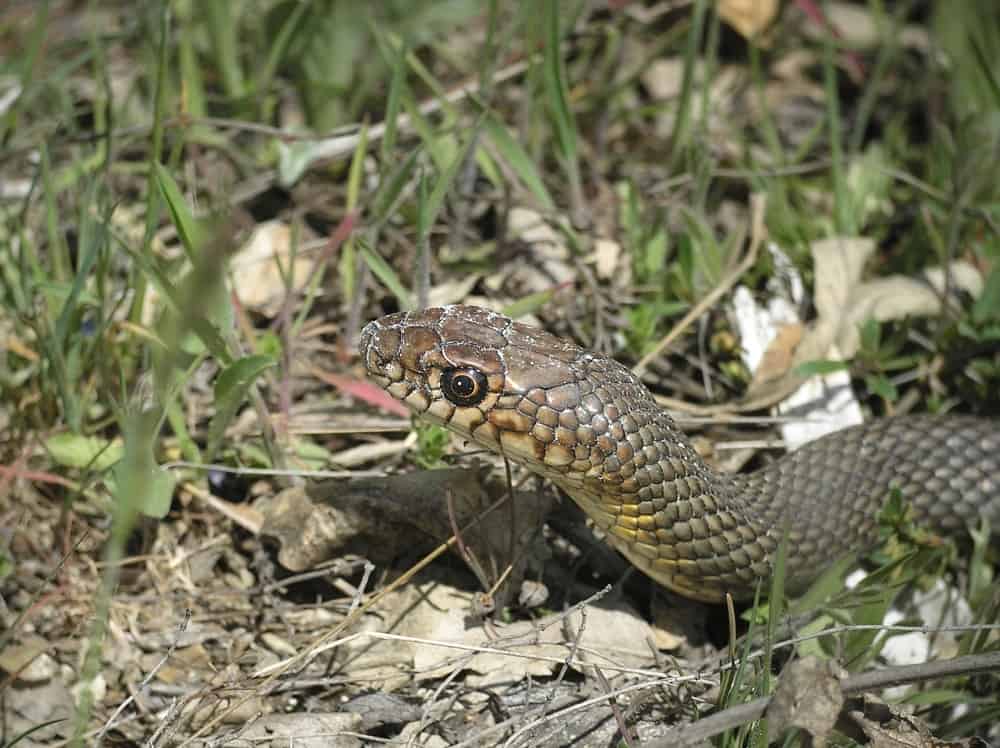
Maximum size: 208cm.
This southern European snake is said to unleash sheer terror upon those who mess with it. Caspian whipsnakes are non-venomous, and feed on reptiles and mammals, the little ground squirrel (Spermophilus pygmaeus) being one favourite. They’re a contender for Europe’s longest snake, with 1.5-2 metres being common.
All this adds to the intimidation factor when they unleash their notoriously foul temperament. Caspian whipsnakes bite readily and without warning, while hissing extremely loudly. They can even jump at you, reaching heights up to 50% of their body length. The German name is “Springnatter”, which translates to jumping snake, and in Kazakhstan it’s believed to jump so aggressively that it causes horses to flee.
The Caspian whipsnake is sparse in some regions. In Moldavia in eastern Romania, they hadn’t been seen since 1937, and locals breathed a sigh of relief. But three showed up in 2007, looking as mean as ever, and ending the 70 year drought.
| 3 | Trinket snake |

Maximum size: 140cm.
The trinket snake is a common Indian serpent, often living in agricultural fields alongside Russell’s vipers and radiated ratsnakes. They have a crafty trick of disguising themselves as bamboo, yet they’re equally likely to use all-out aggression to defend themselves.
If you’re lucky, the trinket snake will only headbutt you, advancing a few centimetres from its original position. If you’re unlucky, they’ll treat you to their vicious, inward pointing (yet non-venomous) fangs. Trinket snakes will bite your finger and gleefully wiggle their fangs back and forth to tear the skin open.
The trinket snake lacks venom, yet will wrap its teeth around a cobra’s entire head, forcing the frightened snake to slither off into the bushes. This species has flexible habitats, yet generally requires at least 2000mm of rainfall per year. Meadow clearings, rainforests and lighter forests are spots where they might be watching and waiting. Their closest evolutionary relative is the radiated ratsnake, which has an aggression problem of its own. While trinket snakes mainly prey on rodents, reptiles such as Calotes versicolor are also confirmed.
| 4 | Ladder snake |
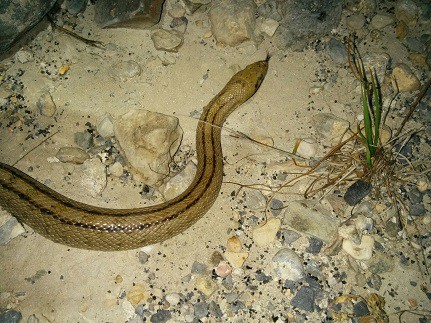
Maximum length: 165.0cm.
The ladder snake is a Spanish species named for its striking square patterns as a juvenile, which slowly fade into adulthood. They’re not named for the ability to angrily pursue you up a ladder, but we wouldn’t be surprised if that happened, for this non-venomous snake is known to be extremely aggressive. The ladder snake will hiss and bite if you invade their personal space. They have a number of defensive tricks, including twisting, thrashing, releasing a foul smell, and wrestling in the palm of your hand. The aggression rises as they age, with young ladder snakes more likely to flee.
Ladder snakes inhabit Portugal and Spain and the far south of France, and have a diet of 85% plus mammals. They mainly live in countryside areas, with crumbling walls, hot dirt tracks and dry hedgerows.
Ladder snakes have the sneaky tactic of invading mammal burrows while they sleep, and swallowing up the entire family. However, they get their comeuppance from the bird kingdom, particularly the short-toed snake eagle, which has a particular taste for them (while ignoring false smooth snakes). This bird threat may be why their aggression is cranked up so high.
| 5 | Beauty ratsnake |
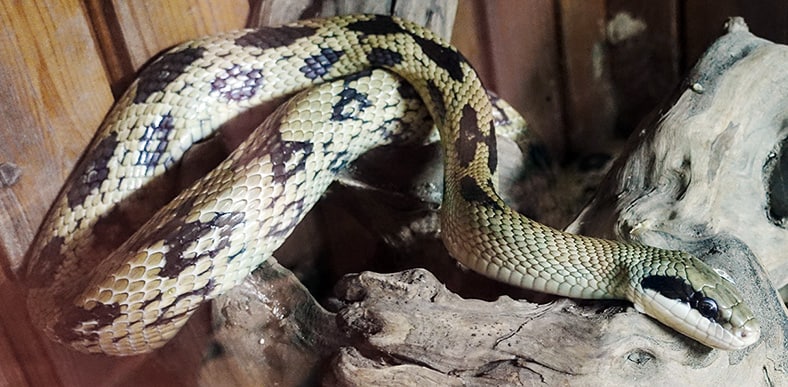
Maximum length: 270cm.
The beauty ratsnake lives in the leafy countryside of China, a place which is supposed to be peaceful. This is a non-venomous constrictor, but one that instantly defaults to biting if anyone gets in its way. Their lunge is supposedly faster than an arrow from a bow, and they begin with an S-shaped coil, with their bodies raised 20-30cm above ground, mouths bared wide.
Beauty ratsnakes like to invade Chinese villages, and they often bite hapless farmers on their way past. They’re also notorious for climbing roofs, putting repairmen at severe risk. As they hunt during the day, encounters with villagers are common. They also hang out in cities, where they snap at people hurrying across roads.
Beauty ratsnakes are unpredictable, as sometimes they’ll sit still like a statue while you clean their cage, while other times they’ll bite in a wide-eyed frenzy. Keepers report that you can only reduce the quantity of bites, not eliminate them altogether. This bitey species relies on mice for its fill, sometimes swallowing 3-5 in one meal.
| 6 | Northern watersnake |
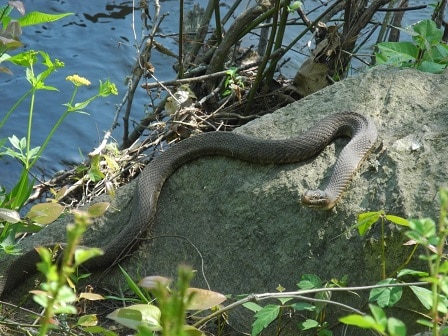
Maximum length: 149.9cm.
Nerodia sipedon is the northerly relative of the brown watersnake (Nerodia taxispilota) of Florida and Louisiana. There’s subtle pattern differences, but another is their personality, as northern watersnakes are far more aggressive.
The northern watersnake loves nothing more than to rest on a branch overhanging a river, watching the world go by. In fact, it loves its life so much that it will react with extreme ferocity, aggression and rage when disturbed. They will defend their resting areas with a passion, and they don’t see humans as an obstacle.
When hunting for fish, northern watersnakes will swim right past boats. They might even change direction and start heading towards you. They lack real weapons except for sharp teeth, but pick one up and there’s a strong chance you’ll feel extreme pain. Northern watersnakes have more powerful jaws than the average snake, and can clamp down hard. While they lack venom, their saliva does contain a mild anticoagulant toxin. This is capable of making a wound bleed far more profusely than usual.
| 7 | Blood python |
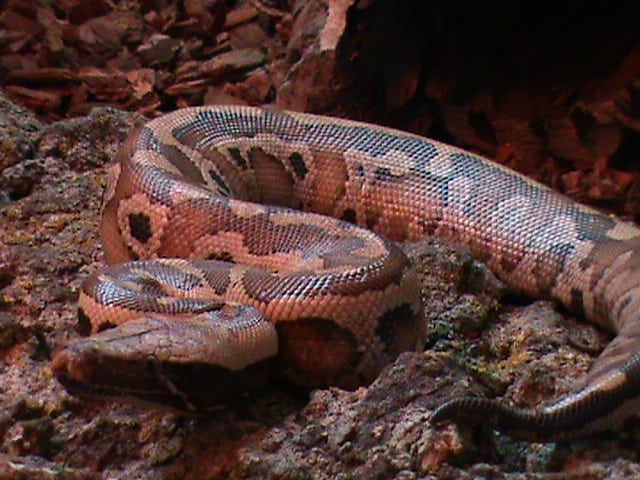
Maximum length: approximately 200cm.
The blood python lives in southern Thailand, peninsular Malaysia, and Sumatra. It’s closely related to the short-tailed python (one of the longest-lived snakes), but has vivid red scales instead of rich brown and black. The mere phrase blood python can inspire a shudder of fear in even the most dedicated reptile enthusiasts. This is a popular snake in the pet trade, and part of the anger management crew that just refuses to calm down. Blood pythons hiss and and snap at their owners, even delivering savage bites as people helpfully bring them food.
In the wild, this is a constrictor like all pythons, which mainly lives in humid swamps within forests (like its short-tailed python neighbour). It’s estimated that from 1996-2015, 900,000 were exported from Indonesia alone for the pet trade.
There’s a twist with this angry snake, as it turns out that blood pythons from Malaysia are far more aggressive. Malaysia was once the main source of exports, creating the terrifying reputation among keepers, but these days exports have switched to Indonesia. A couple of doting keepers insist that they’re lovable pussycats, but blood pythons are still not to be underestimated.
| 8 | Pinesnake (Pituophis melanoleucus) |
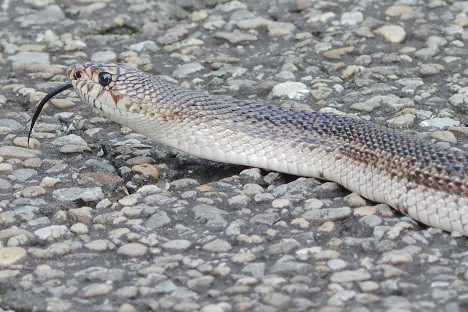
Maximum size: 228.6cm.
This large snake resides in the eastern US, from Florida to Virginia and Delaware. This is an irritable snake, not looking for a fight, but never hesitating to push its snapping jaws in your face if you get on its nerves. Victims testify that their bites are particularly painful. Experts strongly advise acquiring this snake as a baby, to desensitise it to your presence, and even then to be on your guard. Some pinesnakes will hiss and bluff strike in their enclosure, without actually biting.
There’s no obvious reason for this aggression. In the wild, they inhabit pine flatwoods, sandy pine-oak woodland and prairies, where they enjoy soft soils which are easy to dig burrows in (for their prey as well). Pine snakes are constrictors which invade the burrows of rodents, and squeeze them to death after pinning them against a tunnel wall. They’re seldom seen, even in rural neighbourhoods where they’re confirmed, so the viciousness may stem from a lack of contact.
The northern pinesnake also has an unusually loud hiss due to a cartilaginous keel in their throats. Mammals on their menu include the striped skunk and northern short-tailed shrew.
| 9 | Black racer |
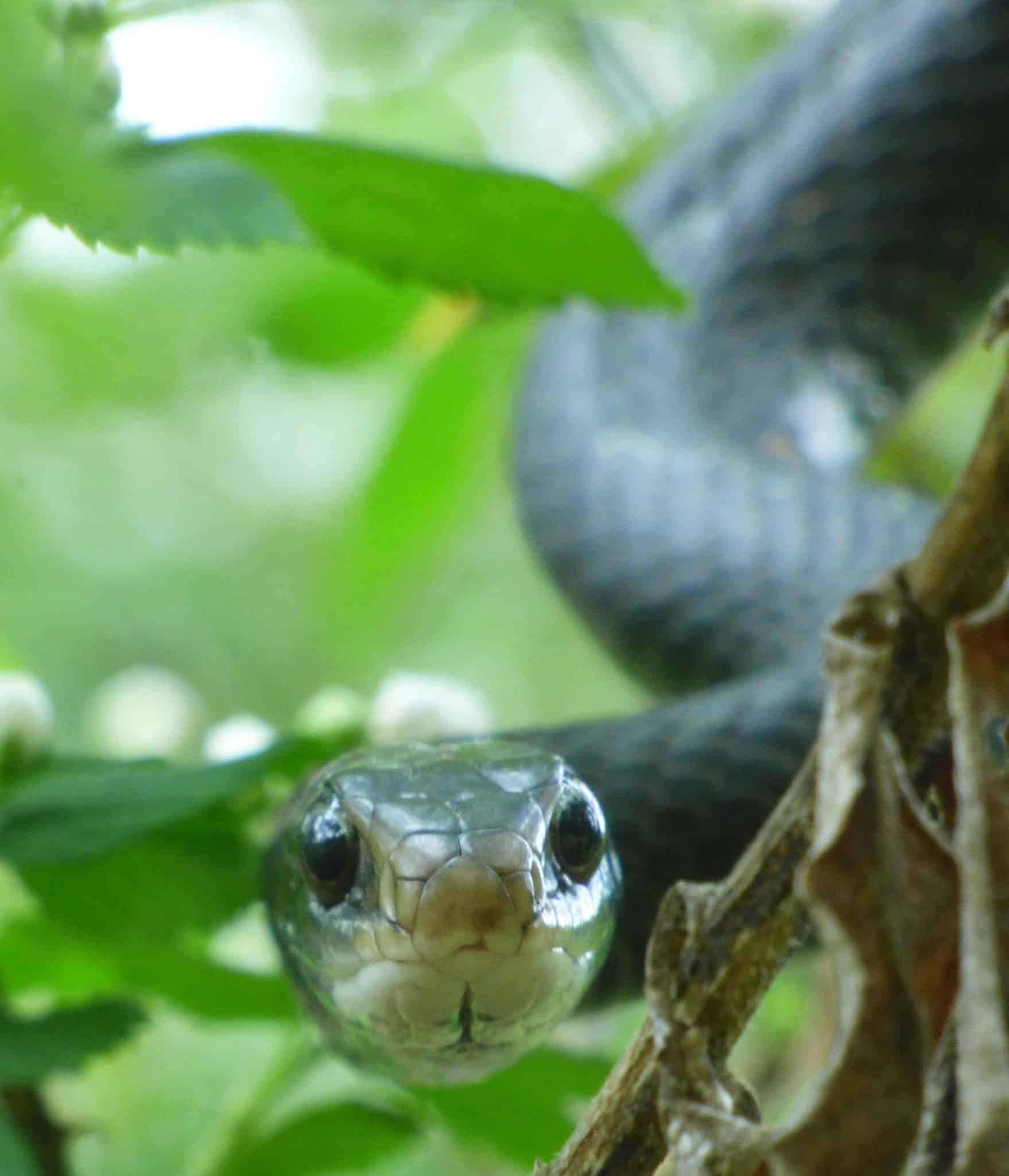
Maximum length: 190.5cm.
A black and slightly less black snake inhabiting almost the entire eastern USA. The black racer looks similar to the black ratsnake from a distance, but the difference is that their bodies are straight when slithering rather than kinked. Another difference is their extra vicious temperament. Black racers have a nervous appearance, and an equally nervous mind. They’re always on the move, slithering around all over the place, and unleash a painful bite whenever their paranoid thought processes deem it appropriate.
If you meet a black racer on a public footpath and expect it to stand aside, then think again. Black racers are known to chase children up suburban streets, and terrify dogs with a piercing hiss. They’re much more likely to chase innocent people than the sluggish cottonmouth, who the original myth surrounds.
Black racers lack venom, but they do have another evil elixir: a mouth full of bacteria. This could cause a wound to become red hot and infected, and guarantee a hospital visit just the same. Black racers aren’t even true constrictors; they’re just agile enough to grab prey, pin them down and swallow them.
| 10 | Burmese python |
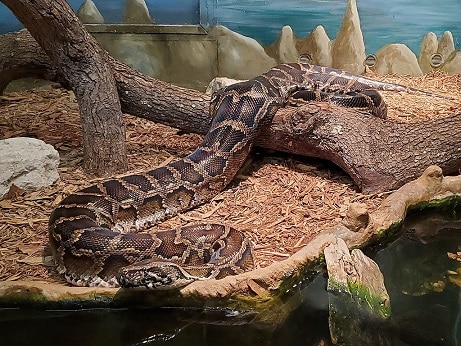
Maximum length: 579cm.
The Burmese python is pure muscle, with every fibre geared towards constricting its prey. It’s one of the world’s longest snakes at up to 5.5 metres, but compared to the absolute longest (the reticulated python), they’re far more aggressive. The Burmese python is responsible for the highest number of attacks on reptile keepers, with up to 20 hospitalisations per year. They’re an invasive species in the Florida everglades, and while they haven’t killed anyone in the wild, a few fatalities have occurred in captivity, with the python wrapping itself around the victim’s neck.
This aggression rears its ugly head whenever food is involved. Burmese pythons are aggressive towards prey in the wild, and in captivity, they can develop a mental association between the human handing them meals and the meals themselves. Before you know it, they’re rearing back for assault whenever you open their cage.
Just recently, a yellow Burmese python escaped from its enclosure in England and was seen on a bedroom windowsill. Everyone had a good laugh later, but a small child would have been a tempting meal. The many colour morphs and unfussy diet increases their popularity as a pet.
